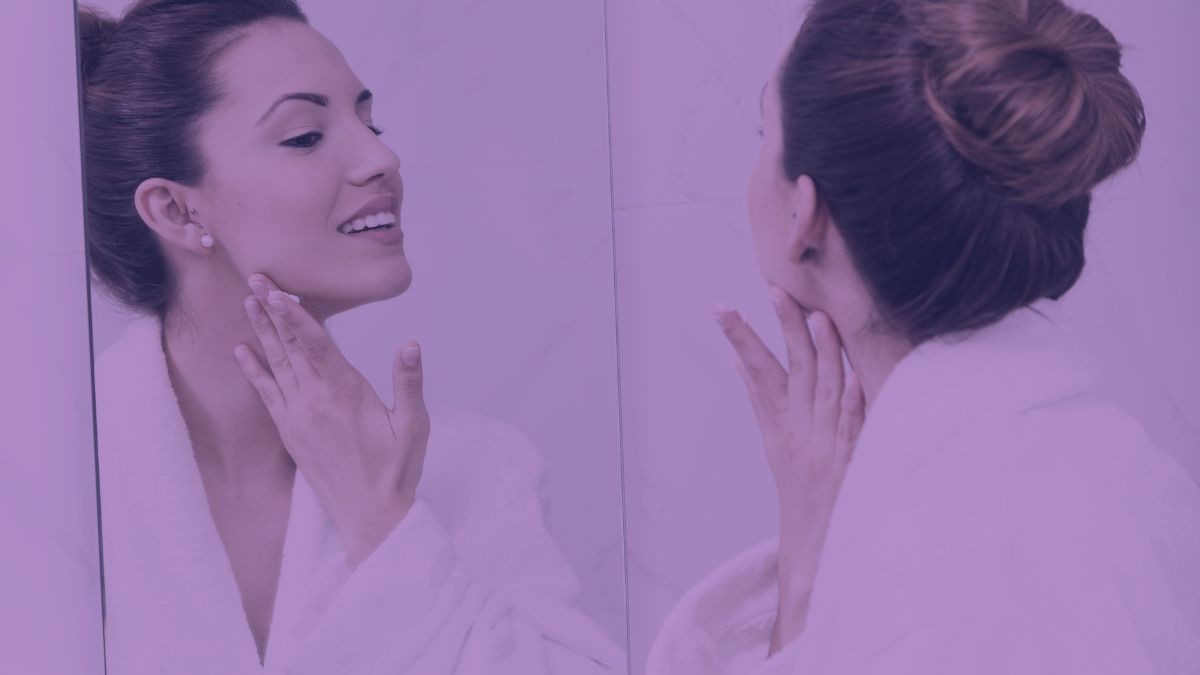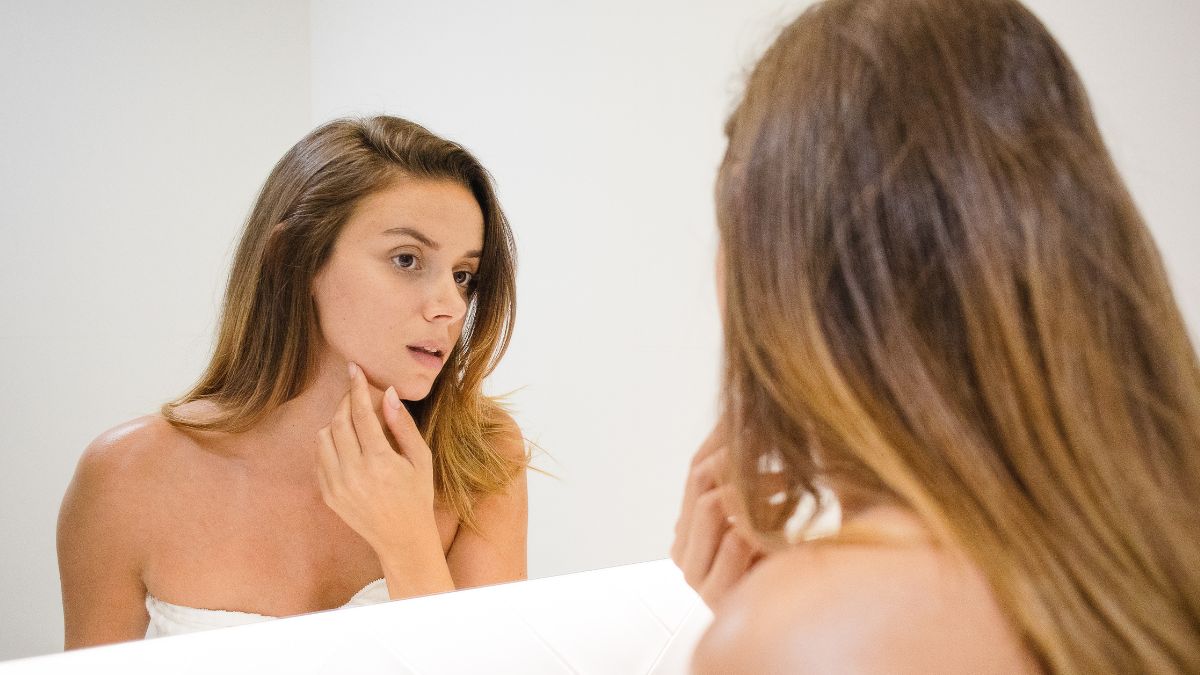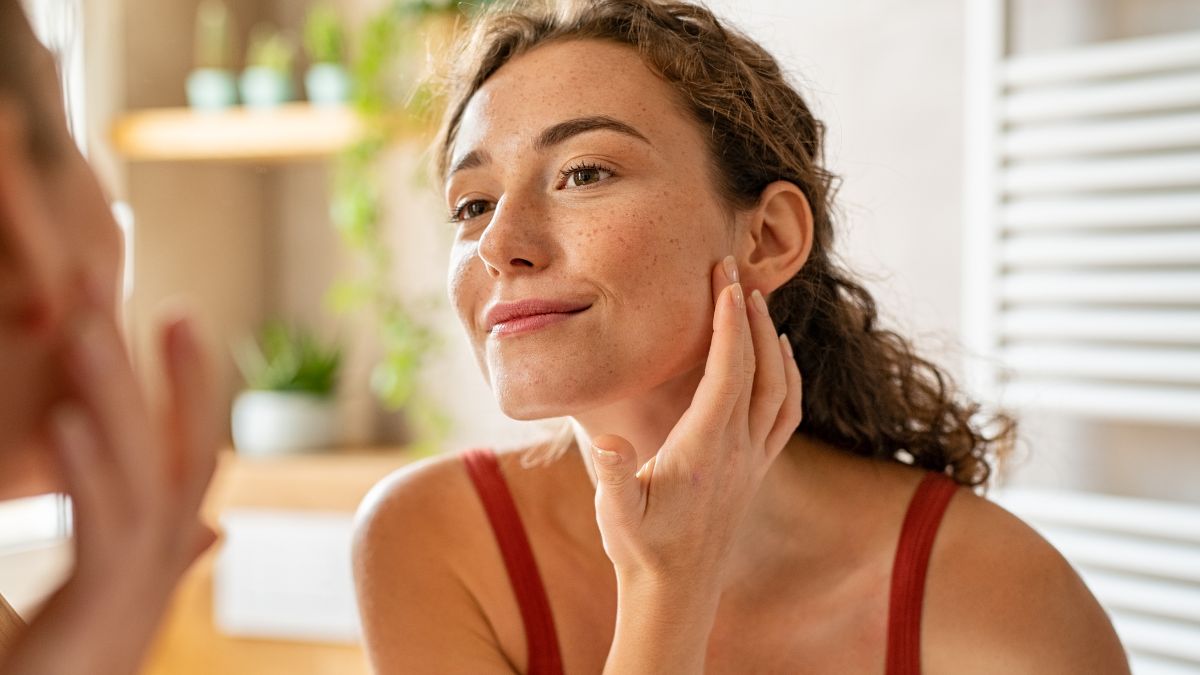Retinol is an active component in over-the-counter skincare products that offers many benefits for the skin.
From minimizing wrinkles to refining skin texture and reducing the severity of inflammatory conditions such as acne, this potent ingredient has been a favorite of skincare enthusiasts for decades.
However, like any other active ingredient, retinol comes with its fair share of risks and side effects.
One of these includes skin damage that can appear as symptoms of redness, irritation, and sensitivity.
Therefore, in this article, I will explain why retinol causes skin damage and how to fix retinol damage while enjoying the maximum benefits of this active ingredient.

What is Retinol & How Does it Work?
Retinol is one of the many vitamin A derivatives available in over-the-counter skincare products that help reduce the appearance of fine lines and wrinkles, uneven skin tone and texture, post-inflammatory scars, and acne.
Once applied to the skin, retinol travels deeper through the epidermal layers, where it binds to retinoid receptors and instructs them to do their job in maintaining the skin cells better.
This action will normalize cell function and influence the skin cells to behave in a healthier and younger way, which basically means encouraging them to renew themselves at a faster rate, resulting in the skin appearing bouncier, more elastic, and younger-looking.
Additionally, by normalizing (or speeding up) the cellular turnover, retinol also aids in purging the dead skin cells stuck inside the pores that have contributed to the formation of micro-comedones, such as blackheads and whiteheads that eventually turn into inflamed pimples.
Therefore, retinol is a one-stop-shop ingredient to help keep your skin looking and feeling younger and healthier.
Can Retinol Cause Skin Damage?

Although efficient at improving pretty much every skin concern under the sun, retinol is known for its side effects, which include dryness, peeling, and irritation that manifest on the skin as soon as you start using this component and can last several weeks until the skin gets used to the active ingredient.
However, besides this initial discomfort, retinol can also cause a few other symptoms you should be aware of as they are signs of skin damage.
Here are some types of skin damage retinol can cause for some people:
Acne
As I already mentioned, retinol is excellent at reducing the severity of acne and even completely clearing up the skin in many cases.
So, how come it’s known for causing acne?
Well, retinol can trigger acne for two main reasons: purging and clogging.
Purging is a natural reaction of the skin when exposed to an active ingredient, like retinol, that encourages it to turn over cells more quickly than usual.
During this process, the skin will throw out or “purge” the clogs that would have become pimples at different points in time all at once, resulting in a sudden yet temporary bump in the number and severity of breakouts.
However, not everyone experiences the dreaded purge when starting retinol, and this usually happens if your skin is already prone to acne.
But, on the other hand, it’s not unheard of for people who have never dealt with acne in their lives to suddenly develop this condition when starting retinol. And although this demographic is rarer than, for example, those who experience purging during their retinol journey because their skin is prone to acne, it’s still very much a real thing and a sign of skin damage caused by retinol.
The second reason why some people experience acne when using retinol is because of clogging. No matter how good the active ingredient is on its own, not every retinol will work for everyone, and if the product you are using contains clogging ingredients your skin can’t tolerate, such as stearates, oils, heavy emollients, and silicones, you might experience blocked pores and breakouts, which is a sign of skin damage.
Rosacea
Retinol-induced rosacea isn’t a common thing, but it can happen if you start using a strong retinol right off the bat.
Retinol is an ingredient that requires getting used to, which is why it is found in skincare products in different strengths, usually ranging from 0.25% to 1%.
If you start with a product that contains 1%, you might be at risk of developing rosacea because your skin isn’t prepped to take such a strong retinol percentage, and when you apply it, the skin is exposed to an ingredient that might be too powerful for its needs, which can cause it to freak out and develop redness, bumps, blotchiness and even swollen patches, which are symptoms associated with rosacea.
Eczema
Eczema is a more common retinol-induced side effect that, similarly to rosacea, can appear when a stronger retinol percentage is introduced to skin that’s not adequately prepped for the products or because retinol isn’t used in the right way.
Retinol is known to be drying and irritating to the skin, especially during the first few weeks while the skin is adjusting to the active ingredient.
Therefore, it is incredibly important that no other active ingredients are used during this time and the skin is kept well hydrated and moisturized to prevent retinol-induced eczema.
Additionally, and as I already described in my article on how to deal with retinol-induced eczema, it is hypothesized that cytokines, which are proteins secreted by certain cells of the immune system, may be important inflammatory mediators in retinoid-induced eczema, as some studies suggest retinol stimulation affects the secretion of both pro-inflammatory and anti-inflammatory cytokines.
Therefore, if you experience eczema while using retinol, slowing down and making simple tweaks in your skincare routine are essential to maintain clear and healthy skin.
Skin Texture & Blotchiness
While retinol can help refine rough and uneven skin texture, it can also be the cause behind it in the first place.
Retinol can sometimes cause textured skin, and this can happen due to overuse of the product or incorrect usage.
Overusing a retinol product can lead to redness, dryness, flaking, and irritation that manifest on the skin as texture and blotchiness.
On the other hand, experiencing a sudden breakout flare-up, especially when first starting retinol, is likely a sign of purge and can cause a temporary texture and blotchiness.
Compromised Skin Barrier
Finally, retinol can cause a compromised skin barrier, especially in the beginning, which is a good enough sign that your skin is damaged.
A compromised skin barrier will cause the skin to become easily irritated, red, and sensitive, even when doing the most mundane things that have never bothered you before, such as using the cleanser you’ve used for a long time or a moisturizer that you know works for your skin.
This happens because retinol will start to push newer and younger cells toward the skin surface, and these cells are not as able to hold onto moisture as the older ones, which can lead to a weaker and more easily damaged skin barrier due to moisture loss.
This is why it’s essential to take it slow and easy when starting retinol, as although a compromised skin barrier is a common occurrence and tends to even itself out as the skin adjusts to the active ingredient, it is no less uncomfortable to deal with, and since there are ways to go around it, it’s best to avoid taking the long and painful road.
How to Fix Retinol Damage?

If your skin has experienced any of the abovementioned side effects and signs of damage, there are a few things you can do to help fix retinol damage and restore your skin back to its normal, healthy state. Here are some of the steps you can take:
Start Low
Even if you were a little impatient and decided to jump straight into the highest retinol percentage or started using it more frequently than recommended without slowly building up and giving your skin time to adjust, it’s never too late to take a step back.
The first thing you want to do is give your skin some time to recover from the symptoms of damage before resuming your use of retinol. This break should last anywhere from one to two weeks, depending on how severe the damage is.
After that, you want to start by introducing the lowest percentage of retinol possible and gradually increasing it over time, allowing your skin to adjust.
If your skin is more resilient, moving to the next level will take at least six months. On the other hand, if your skin is dry, sensitive, or reactive, don’t increase the retinol strength before a year of consistently using it has passed.
Use Retinol Sparingly
If you already bought an expensive retinol that turned out to be too strong for your skin but don’t want to waste your money by throwing it away, there is an option.
You can still use the retinol, but sparingly, such as twice a week, and paired with other ingredients that can help soothe the skin.
Additionally, another great option is to apply a moisturizer before applying retinol, as this will create a barrier that can help prevent irritation and redness and will allow you to use the retinol a bit more frequently without feeling the side effects.
Repair The Skin Barrier
Repairing the skin barrier is the most important thing to do to relieve the symptoms of retinol-induced skin damage because only once the skin barrier is restored will your skin be able to hold onto moisture properly and start healing.
To help repair the damaged skin barrier, you need to replace your regular cleanser with a much gentler option that ideally doesn’t foam up, as the foaming agents found in cleansers are often too harsh and drying for damaged skin.
Additionally, you need to incorporate a hydrating toner or serum containing hydrating ingredients like hyaluronic acid and glycerin and soothing components like Centella Asiatica, chamomile extract, licorice extract, and niacinamide.
Finally, you want to finish off your routine with a moisturizer that contains ceramides, which are essential components of the skin barrier that help to hold moisture within the skin as well as lock out environmental aggressors, as these will be key in helping to restore the skin to its normal healthy state.
Avoid Using Other Active Ingredients
Other active ingredients in skincare products, such as exfoliating acids and vitamin C, should also be avoided while your skin is recovering from retinol damage.
Exfoliating acids work by dissolving the bonds between dead skin cells and encouraging them to shed while also speeding up cell turnover; therefore, if you are trying to reduce skin damage and help the dead skin cells on the skin surface hold on to moisture more efficiently, removing them with active ingredients can be counterproductive.
On the other hand, vitamin C is also a strong antioxidant, and its use should be avoided until the skin heals and adjusts to retinol first, as it can be too aggressive for damaged skin that is already trying to repair itself.
Wear Sunscreen
Another crucial step when dealing with retinol skin damage is always wearing a broad-spectrum sunscreen daily, as this will help protect your skin from environmental aggressors, provide antioxidants and help protect the skin from sun damage.
Sun protection is especially important when using retinol because, while it can help reverse signs of photo-aging, it also increases photosensitivity and makes the skin more vulnerable to sunburns and long-term UV damage such as discoloration, melasma, and even skin cancer.
Give Your Skin a Break
Whether from makeup or skincare products, sometimes you have to give your skin a break, as this will help it recover and repair itself more efficiently without relying on products too much.
At the end of the day, don’t forget that our skin is an incredibly smart organ composed of appendages that work together to repair, heal, and keep it functioning against all odds.
And while it might take some time, your skin will eventually heal itself without necessarily needing a product always to be involved.
And while some products can help speed up the healing process, sometimes, the best thing you can do is let your skin recover naturally.
We can help it by providing the right nourishing ingredients, but once in a while, a full-on break can be the best option.
The Best Retinols for Sensitive & Damaged Skin
If you are a retinol beginner or have sensitive and reactive skin, it is best to start with gentle retinoids that are less likely to cause irritation and skin damage.
Here are some of the best retinols for sensitive and damaged skin and retinol beginners:
LilyAna Naturals – Retinol Cream, $25
The LilyAna Naturals Retinol Cream is formulated with hydrating, soothing, and nourishing ingredients like aloe, hyaluronic acid, green tea, shea butter, vitamin E, and jojoba oil to nurture and soften dry, sensitive skin while helping combat the visible signs of aging such as wrinkles, fine lines, uneven skin tone, rough texture, and loss of firmness.
Best for dry skin.
Osmosis +Beauty – Calm – Gentle Retinal Serum, $85
Osmosis’s MD Calm Gentle Retinal Serum is specially designed for the most sensitive skin types who want to introduce retinol into their skincare routine and enjoy its anti-aging benefits.
The rich, creamy serum contains a blend of antioxidants and soothing botanicals to rejuvenate the skin, restore brightness and suppleness, and strengthen the skin barrier so that it can renew itself easily.
Best for sensitive and reactive skin.
Vivant Skin Care – Derm-A-Renew, $122
The Vivant Derm-A-Renew is a lightweight, milky serum formulated with brightening ingredients such as kojic acid and mildly exfoliating lactic acid to hydrate, nourish and protect the skin.
It also contains retinyl propionate, a proprietary form of retinol that is gentler and less irritating than other forms, along with oligopeptides to soothe, reduce redness and inflammation, and help minimize breakouts while fighting the visible signs of aging such as sagging skin, fine lines, and wrinkles.
Best for sensitive and acne-prone skin.
Paula’s Choice – Clinical 0.3% Retinol + 2% Bakuchiol Treatment, $62
Paula’s Choice CLINICAL 0.3% Retinol + 2% Bakuchiol Treatment is specially formulated for retinol beginners and those with sensitive and reactive skin.
A combination of retinol, antioxidant-rich bakuchiol, and peptides help to reduce the appearance of wrinkles and fine lines while providing nourishing hydration to the skin.
It also helps even out skin tone, refines texture, and improves firmness.
Best for retinol beginners.
L’Oréal – Revitalift Pressed Night Moisturizer with Retinol, $40
L’Oréal’s Revitalift Pressed Night Moisturizer with Retinol is a light, anti-aging night cream that helps firm and plump up the skin while reducing wrinkles and fine lines specifically formulated to be gentle enough for retinol beginners and those with dry, mature skin.
It also contains niacinamide, a barrier-repairing antioxidant that helps soothe and brighten the skin, and a proprietary 12% complex consisting of panthenol, glycerin, and hyaluronic acid to hydrate and plump the skin overnight and improve its elasticity and glow.
Best for dry and mature skin and retinol beginners.

My name is Simone and I am a certified skin specialist. I created this website to teach my readers how to take great care of their skin and I also like to occasionally share my honest opinions on skincare products I’ve tried. You can learn more about me here.
